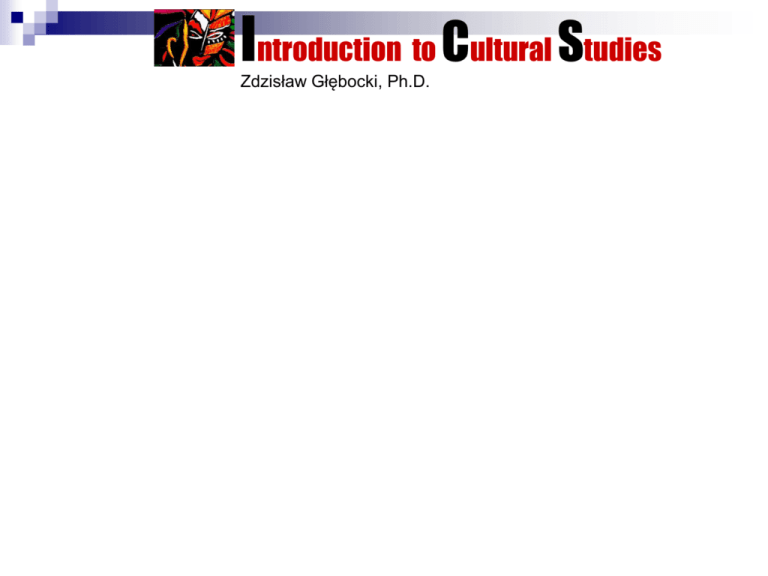Slajd 1
advertisement

Introduction to Cultural Studies Zdzisław Głębocki, Ph.D. Introduction to Cultural Studies Zdzisław Głębocki, Ph.D. The purpose of the course is to: 1. Familiarize students with general issues of cultural studies, taking the point of view of cultural anthropology. 2. Prepare students to handle cultural topics in their future diploma work. 3. Enable students to function better in English-speaking cultures and in global community. 4. Prepare students to participate in their own culture more consciously. Introduction to Cultural Studies Zdzisław Głębocki, Ph.D. Topics: Human Culture Language and Culture Patterns of Subsistence Economic Systems Social Organization Kinship Sex and Marriage Process of Socialization Ethnicity and Race Political Organization Social Control Anthropology of Religion Culture Change Introduction to Cultural Studies Zdzisław Głębocki, Ph.D. Course Requirements: - Participation in lectures is not compulsory BUT - Students are expected to complete assigned week-to-week tasks (readings and activities) - Final written examination: - During the exam, you will be responsible to know the issues, concepts and terminology discussed in the assigned readings and covered during the lecture. - During the exam you will report on the assigned article. The assigned article will be in Polish and the question(s) refering to it will also be in Polish. You are also expected do conduct a short research on the author of the article. Introduction to Cultural Studies Zdzisław Głębocki, Ph.D. Readings: Haviland, William A., Cultural Anthropology. The Human Change, Wadsworth, 2005. Burszta, J. Wojciech, Antropologia Kultury, Zysk i S-ka, 1998. Kłoskowska, Antonina, Socjologia Kultury, PWN, 1983. Nowicka, Ewa, Świat człowieka, świat kultury. Systematyczny wykład problemów antropologii kulturowej. PWN, 1997. Antropologia Kultury. Zagadnienia i wybór tekstów, WUW, 2005. Introduction to Cultural Studies Laurie Anderson The Ugly One With The Jewels Key-words: anthropologist birdlike tiny tower over (sb) mill lopsided charred braid puddle thatched cupcake beaver dam rimmed stare transparent safekeeping Introduction to Cultural Studies Laurie Anderson The Ugly One With The Jewels Anthropological perspective Meeting “The Other”, culture loss, fieldwork, informants, linguistic anthropology, participant observation, ethnology (systematic comparisons), ethnography, cultural system, holistic perspective, value system (sense of beauty), social/gender roles/identity, globalization, culture change, acculturation. The Sacred Rac An Indian anthropologist, Chandra Thapar, made a study of foreign cultures which had customs similar to those of his native land. One culture in particular fascinated him because it reveres one animal as sacred, much as the people in India revere the cow. The tribe Dr. Thapar studied is called the Asu and is found on the North American continent north of the Tarahumara of Mexico. Though it seems to be a highly developed society of its type, it has an overwhelming preoccupation with the care and feeding of the rac - an animal much like a bull in size, strength and temperament. In the Asu tribe, it is almost a social obligation to own at least one if not more racs. Anyone not possessing at least one is held in low esteem by the community because he is too poor to maintain one of the beasts properly. Some members of the tribe, to display their wealth and prestige, even own herds of racs. Unfortunately the rac breed is not very healthy and usually does not live more than five to seven years. Each family invests large sums of money each year to keep its rac healthy and shod, for it has a tendency to throw its shoes often. There are rac specialists in each community, perhaps more than one if the community is particularly wealthy. These specialists, however due to the long period of ritual training they must undergo and to the difficulty of obtaining the right selection of charms to treat the rac, demand costly offerings whenever a tribesman must treat his ailing rac. At the age of sixteen in many Asu communities, many youths undergo a puberty rite in which the rac figures prominently. The youth must petition a high priest in a grand temple. He is then initiated into the ceremonies that surround the care of the rac and is permitted to keep a rac. Although the rac may be used as a beast of burden, it has many habits which would be considered by other cultures as detrimental to the life of the society. In the first place the rac breed is increasing at a very rapid rate and the Asu tribesmen have given no thought to curbing the rac population. As a consequence the Asu must build more and more paths for rac to travel on since its delicate health and its love of racing other racs at high speeds necessitates that special areas be set aside for its use. The cost of smoothing the earth is too costly for any one individual to undertake, so it has become a community project and each tribesman must pay an annual tax to build new paths and maintain the old. There are so many paths needed that some people move their homes because the rac paths must be as straight as possible to keep the animal from injuring itself. Dr. Thapar also notes that unlike the cow, which many people in his country hold sacred, the excrement of the rac cannot be used as either fuel or fertilizer. On the contrary, its excrement is exceptionally foul and totally useless. Worst of all, the rac is prone to rampages in which it runs down anything in its path, much like stampeding cattle. Estimates are that the rac kills thousands of the Asu in a year. Despite the rac's high cost of its upkeep, the damage it does to the land, and its habit of destructive rampages, the Asu still regard it as being essential to the survival of their culture. „The Sacred Rac” Rac, Asu Care and feeding Throw its shoes Rac specialists Offerings Treat the rac Puberty rite Paths Excrement Car, USA, Maintenance Change tires Mechanics Payment Repair Getting a driving licence Roads, highways Car exhaust (fumes) Introduction to Cultural Studies Zdzisław Głębocki, Ph.D. „Millennium: Tribal Wisdom and the Modern World" (1992) Harvard anthropologist Maybury-Lewis looks toward the tribal societies that Western civilization has swept aside for insight into how their traditions may be able to prevent humans from destroying themselves in the next millennium. PART ONE: „The shock of the other”





